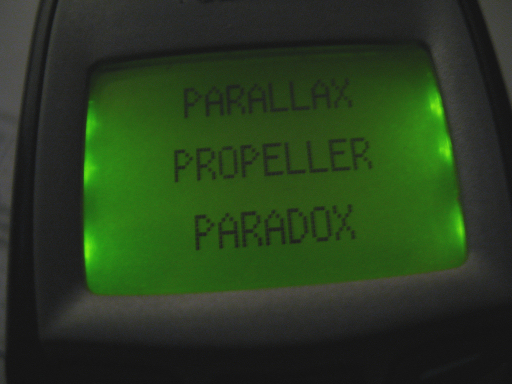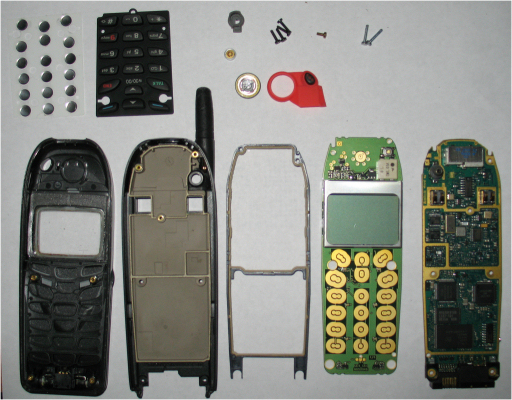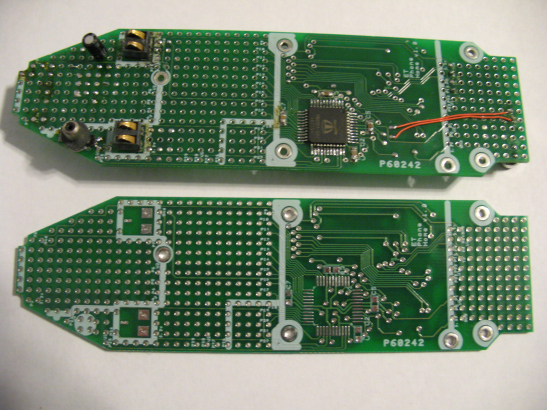EtPhoneHome v1.0 - A Nokia 6150(like) pcb redone with two propellers. PCD8544 l
 Clock Loop
Posts: 2,069
Clock Loop
Posts: 2,069
This is EtPhoneHome v1.0
It is a nokia model 6150 (or like that has pcd8544 display in it)
The phone was slightly modified to remove the conductive rubber on the inside shell housing to prevent direct shorts on the new pcb.
The pcb houses two propeller chips powered from a 3.3v regulator that draws its power from the original phone battery.
(the prop might be able to run on the batterys raw voltage of 4v, i'll try it if someone asks.)
This platform does NOT have a charging circuit, I use an unmodified WORKING 6150 to recharge my batteries.
IT is a barebones circuit with prototyping areas on it. The prop is programmed from a header at the bottom which connects to the prop plug.
The second prop on the pcb is pretty much open for custom use, and is programmed using prop 1 with an internal binary.
Prop 1 programs and runs prop 2.
There is no wireless communications, but one could be added to the pcb via the prototyping holes and pin access.
▔▔▔▔▔▔▔▔▔▔▔▔▔▔▔▔▔▔▔▔▔▔▔▔
TERMS OF USE: MIT License
"Permission is hereby granted, free of charge, to any pers...........................
..............................OMITTED FOR FORUM...............................................
.................. OF OR IN CONNECTION WITH THE SOFTWARE OR THE USE OR OTHER DEALINGS IN THE SOFTWARE. "
The dsp/fpga king is dead, long live the prop.
Post Edited (Clock Loop) : 8/5/2010 11:08:35 AM GMT
It is a nokia model 6150 (or like that has pcd8544 display in it)
The phone was slightly modified to remove the conductive rubber on the inside shell housing to prevent direct shorts on the new pcb.
The pcb houses two propeller chips powered from a 3.3v regulator that draws its power from the original phone battery.
(the prop might be able to run on the batterys raw voltage of 4v, i'll try it if someone asks.)
This platform does NOT have a charging circuit, I use an unmodified WORKING 6150 to recharge my batteries.
IT is a barebones circuit with prototyping areas on it. The prop is programmed from a header at the bottom which connects to the prop plug.
The second prop on the pcb is pretty much open for custom use, and is programmed using prop 1 with an internal binary.
Prop 1 programs and runs prop 2.
There is no wireless communications, but one could be added to the pcb via the prototyping holes and pin access.
▔▔▔▔▔▔▔▔▔▔▔▔▔▔▔▔▔▔▔▔▔▔▔▔
TERMS OF USE: MIT License
"Permission is hereby granted, free of charge, to any pers...........................
..............................OMITTED FOR FORUM...............................................
.................. OF OR IN CONNECTION WITH THE SOFTWARE OR THE USE OR OTHER DEALINGS IN THE SOFTWARE. "
The dsp/fpga king is dead, long live the prop.
Post Edited (Clock Loop) : 8/5/2010 11:08:35 AM GMT







Comments
The keypad, power button, lcd, led backlight, speaker and flip flap are all operational, the prop can use them. The mic from the phone can be reused.
I didn't get the buzzer working, not sure what circuitry it needs. I wired it to the prop but it might need more power.
I made the lcd driver, and included an extensive description of each parameter to get this lcd working correctly.
The hardest part was figuring out how I needed to tell the lcd that I was using 3.3v.
▔▔▔▔▔▔▔▔▔▔▔▔▔▔▔▔▔▔▔▔▔▔▔▔
TERMS OF USE: MIT License
"Permission is hereby granted, free of charge, to any pers...........................
..............................OMITTED FOR FORUM...............................................
.................. OF OR IN CONNECTION WITH THE SOFTWARE OR THE USE OR OTHER DEALINGS IN THE SOFTWARE. "
The dsp/fpga king is dead, long live the prop.
Post Edited (Clock Loop) : 8/5/2010 11:40:11 AM GMT
The content is still working.